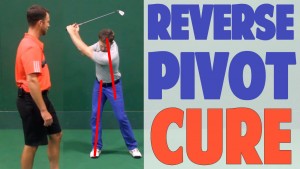
Do you struggle with a reverse pivot? Do you feel like your weight falls around in the swing? Like you aren’t as athletic as you would like?
In this video I am going to show you a neat trick using the right leg. We will keep it angled inward as we swing to the top, which will allow for a good amount of spine tilt and a very consistent swing.
What's Covered: How to use the right leg to eliminate a reverse pivot.
Golf Pros Featured:
Instructors Featured:
Video Duration: 2:49
Watch This Video Now!
Normally, this video in our step-by-step, course-based training is only available to our All Access Members...
But I'll let you watch this ONE video today only... because I can already tell I'm going to like you !

Video Transcription:
Clay: Hi guys, so one of the most common things I see in golf, one of the biggest mistakes is letting the hips slide to the right and getting a little bit of a reverse pivot, or losing that angle away that we talked about we know is so crucial to being consistent in golf.
So Michael here is going to demonstrate this for us, and we’re going to first show you the incorrect way.
So go ahead and set up there Michael, and show me what happens, what a lot of people will do when they sway their hips to the right, and then the upper body starts to lean in back.
So you can see I’ve lost my spine tilt, notice again, go back to address there.
Notice again how his head’s going to start to move back to the left as he’s going this way, and then usually what happens is it’s going to fall to the right as he’s going in the downswing.
The head starts moving all over the place, the spine’s moving all over the place, and it’s really just tough to be consistent when you’re doing that.
Like I said, it’s one of the most common things that we have.
Today what Michael’s going to do here is as he goes to the top, we’re going to make sure that we keep a bit of an angle with the right leg to allow us to load into the right side without having those hip sways.
So go ahead and setup there, and you’ll notice as he sets up at address, the angle of the right leg is going to be a little inward, and as he goes to the top of the swing, he’s going to keep a slight inward angle of the right leg.
That’s going to keep his hips in position there. So what does that feel like to you, what feel like you’re doing wrong?
Michael: Right now I feel like there’s a lot of pressure right on the inside of my back foot here, on my right foot.
Feels like it’s turned, when I do it correctly I’m turning into the inside and it’s more pressure in the ankle, and I feel it really tight in my glute on the way back.
When the hips get popped out to the outside, the weight feels on the outside of my foot and the glute feels like it’s really not doing anything at all.
Clay: Absolutely. So whenever you’re swaying your hips to the right, the weight is naturally going to transfer to the outside of the foot.
You’ll often see people whose inside of their foot even lifts up off the ground like this as they’re getting that sway.
He’s saying, which is exactly correct, that you’re going to feel weight on the inside of the right foot toward the ankle.
So go ahead and do this one more time, you’ll see how the hip stays nice and stable, angled in, no hip sway, keeping a good tilt away from the ball, same as it was at address, then he can come on through to a good full swing.
It’s going to be nice and consistent, the head’s going to stay stable, and his swing is going to be very consistent as a result.
So go ahead and do about 100 repetitions of this. Pull out your camera, draw a line on that right leg.
The line that’s at address should be the same line that you have at the top of the swing.
If you’re letting that hip sway out a little bit, then we’re going to work on keeping that forward.
So one last tip for you here, as I go to the top, I want to make sure that my right knee is facing forward.
As my right knee starts to angle out, that allows my hips to sway, and allows things to fall apart.
So get those 100 repetitions in, once you feel very comfortable with that on camera, making sure it’s correct, then you can go out to the range, start to hit some golf balls, and start to get a lot more consistent.
So good luck to you guys, thanks Michael, and we’ll see you guys soon.

